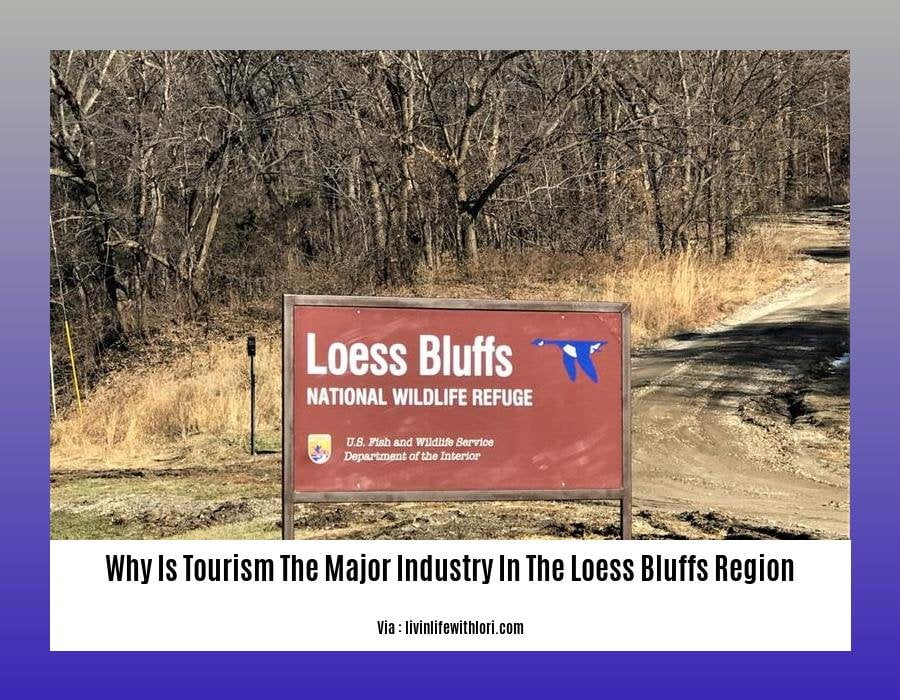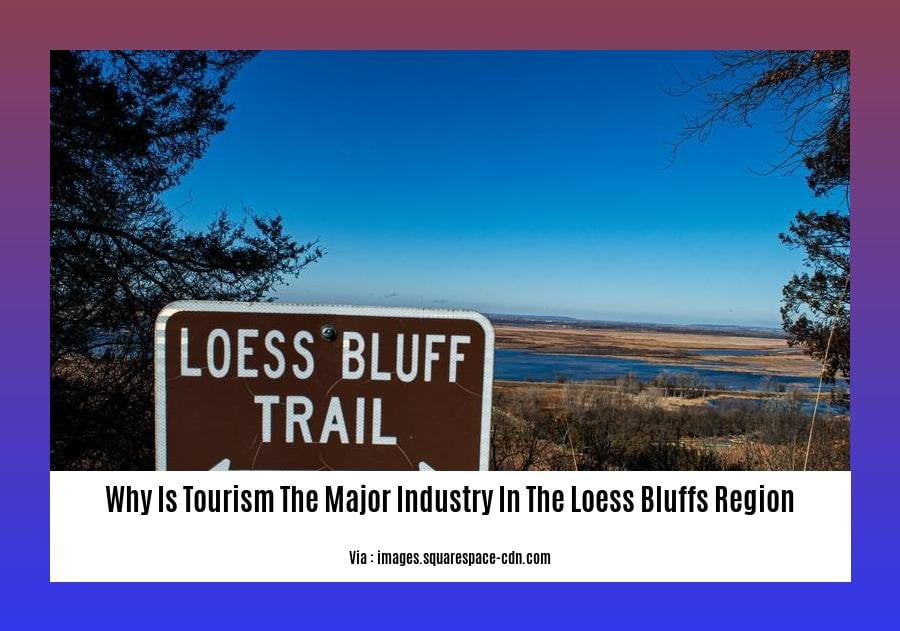[Why Is Tourism the Major Industry in the Loess Bluffs Region?] Tourism has emerged as the predominant industry in the Loess Bluffs region, attracting visitors from around the globe and contributing significantly to its economy. Its picturesque landscapes, rich cultural heritage, and unique geological formations have made it a popular destination for outdoor enthusiasts, nature lovers, and history buffs alike.
Key Takeaways:
- The Loess Bluffs region is known for its captivating natural features, such as towering loess bluffs.
- Tourism has emerged as a primary industry due to the region’s distinctive geological formations.
- Tourism contributes to the local economy by providing employment and revenue for businesses.
- The Loess Bluffs National Wildlife Refuge and historical sites add to the region’s cultural and recreational appeal.
Why Is Tourism the Major Industry in the Loess Bluffs Region?

Unveiling Nature’s Canvas: The Allure of the Loess Bluffs
Immerse yourself in the captivating tapestry of the Loess Bluffs region, where nature’s artistry unfolds before your eyes. The towering bluffs, shaped by millenniums of wind-sculpted sediment, stand as majestic reminders of Earth’s dynamic history. Their unique geological formations offer a breathtaking backdrop for nature enthusiasts, hikers, and photographers alike.
A Sanctuary for Wildlife and Adventure
Nestled within the region’s embrace is the Loess Bluffs National Wildlife Refuge, a haven for a diverse array of wildlife. From the elusive bobcat to the majestic eagle, the refuge’s rich ecosystem provides an unparalleled opportunity for wildlife viewing and outdoor recreation. Visitors can embark on hiking trails, paddle through serene waterways, and revel in the tranquility of this natural sanctuary.
History Unfolds: A Tapestry of the Past
The Loess Bluffs region is not merely a scenic wonderland but also a repository of historical significance. Archaeological discoveries and landmarks dot the landscape, offering glimpses into the lives and cultures of those who have walked these lands before us. From ancient Native American settlements to remnants of early European exploration, the region’s past is an interwoven thread in its present-day tapestry.
Tourism: A Lifeline for the Local Economy
The allure of the Loess Bluffs region has not only captivated visitors but has also fueled a thriving tourism industry. This influx of visitors provides employment opportunities, generates revenue for local businesses, and supports the preservation of the region’s natural and historical treasures. Tourism serves as a vital lifeline for the communities that call the Loess Bluffs home.
Conclusion
The Loess Bluffs region stands as a testament to the profound allure of nature, the enduring legacy of history, and the transformative power of tourism. By embracing its unique attributes, the region has fostered a sustainable industry that benefits both visitors and locals alike. The Loess Bluffs region is a testament to the vibrant interplay between tourism and the preservation of our natural and cultural heritage.
Explore the history of the growth of tourism and witness the incredible journey of how tourism evolved into a global phenomenon. Dive into the The Growth Of Tourism to uncover the factors that fueled its rapid expansion. Embark on a journey of discovery with the History Of Tourism and trace its roots from ancient times to the present day. Delve into the The Growth Of Tourism Industry and gain insights into its economic and social impact on destinations worldwide.
Development of Infrastructure

Development of infrastructure is the backbone of a thriving tourism industry, just like the sturdy bones that support a healthy body. As people travel to our region, improved highways and airports help them get here conveniently, enticing them to explore our area’s unique experiences. Think of it as a welcoming mat that sets the tone for their adventure.
A robust infrastructure is the backbone of tourism development, providing the foundation for growth and enhancing the overall visitor experience. It encompasses various aspects that support and facilitate tourism activities:
Transportation networks: Efficient highways, railways, and airports connect tourists to destinations, making travel convenient and accessible.
Accommodation facilities: Hotels, resorts, and guest houses offer comfortable and diverse options for travelers, catering to their accommodation needs.
Tourist attractions: Well-maintained parks, museums, and historical sites enhance the tourist experience and create lasting memories.
Information infrastructure: Cloud computing and data analysis aid in personalized recommendations and innovative market segmentation for the tourism industry.
Investing in infrastructure creates a ripple effect, boosting local economies and generating revenue through increased tourism. It fosters job creation, supports businesses, and elevates the standard of living for residents. Imagine a beautifully designed park where tourists and locals alike gather, stimulating local businesses and creating a vibrant community atmosphere.
Key Takeaways:
- Infrastructure supports the creation of parks, gardens, museums, and other attractions that enhance the tourist experience.
- Investment in tourism infrastructure contributes an impressive 10.35% to global GDP annually.
- Failure to address infrastructure deficiencies may reduce competitiveness and harm the tourism industry.
- Sustainable tourism requires managing infrastructure development to minimize environmental impact and ensure the long-term viability of tourism.
Sources:
- Why Infrastructure is Crucial to the Growth of Travel and Tourism
- The Importance of Tourism Infrastructure Development
Promotion and marketing strategies
The Loess Bluffs region has leveraged innovative promotion and marketing strategies to establish itself as a major tourism destination. Here’s an overview:
Digital Marketing
In the digital age, online platforms have become crucial for reaching potential tourists. The region has embraced digital marketing strategies such as:
- Social media marketing: Engaging with potential visitors on social media platforms like Facebook, Instagram, and Twitter.
- Email campaigns: Nurturing relationships with subscribers through targeted email campaigns showcasing the region’s attractions.
- Content marketing: Creating and distributing valuable content, such as blog posts and videos, to educate and inspire travelers.
Storytelling and Niche Marketing
The Loess Bluffs region has effectively communicated its unique story and targeted specific market segments. They have:
- Crafted a compelling narrative: Positioned the region as a destination rich in natural beauty, wildlife, and historical significance.
- Identified niche markets: Focused on attracting hikers, bikers, birdwatchers, and history buffs by highlighting the region’s appeal to these specific interests.
Collaboration and Partnerships
Collaboration has played a vital role in promoting the Loess Bluffs region. They have:
- Partnered with local businesses: Teamed up with hotels, restaurants, and tour operators to offer package deals and joint promotions.
- Formed alliances with regional organizations: Collaborated with neighboring states and tourism boards to promote the wider region as a whole.
Sustainability and Responsibility
The region has prioritized responsible tourism practices, which has resonated with eco-conscious travelers. They have:
- Emphasized environmental conservation: Highlighted the region’s commitment to protecting its natural resources and wildlife.
- Promoted local businesses: Supported local businesses that adhere to sustainable practices, creating a positive impact on the local economy.
Key Takeaways:
- Digital marketing has become essential for reaching potential tourists.
- Storytelling and niche marketing help differentiate the region and attract specific market segments.
- Collaboration with local businesses and organizations fosters a supportive tourism ecosystem.
- Emphasizing sustainability and responsibility appeals to eco-conscious travelers.
Citations:
- The Role of Marketing Strategies in the Tourism Industry
- Effective Tourism Marketing and Promotion Strategies in 2024
Impacts on local culture and environment
When a region becomes a tourist hotspot, it inevitably impacts local culture and environment. It can be a balancing act to sustain the positives while mitigating the negatives.
Positive impacts of tourism can include economic growth and increased opportunities for local businesses. Tourism can also shine a light on a region’s history and culture, showcasing what makes it unique.
However, increased tourism can also lead to negative impacts, such as overcrowding and pollution, that can strain the environment and local culture. The influx of tourists can alter the dynamics of local communities, leading to concerns such as gentrification and displacement.
Managing the impacts of tourism requires careful planning and cooperation between stakeholders, including local communities, businesses, and governments. It’s essential to develop sustainable tourism practices that minimize environmental damage and preserve local culture.
Key Takeaways:
- Tourism can have significant economic, cultural, and environmental impacts on a region.
- Balancing the positive and negative impacts of tourism is crucial for sustainable development.
- Sustainable tourism practices can include reducing pollution, preserving natural resources, and supporting local communities.
- Collaboration between stakeholders is essential for managing the impacts of tourism and ensuring its long-term benefits.
Relevant URL Sources:
- Tourism’s Impact on Local Culture and Environment
- Sustainable Tourism: A Guide for Local Governments















